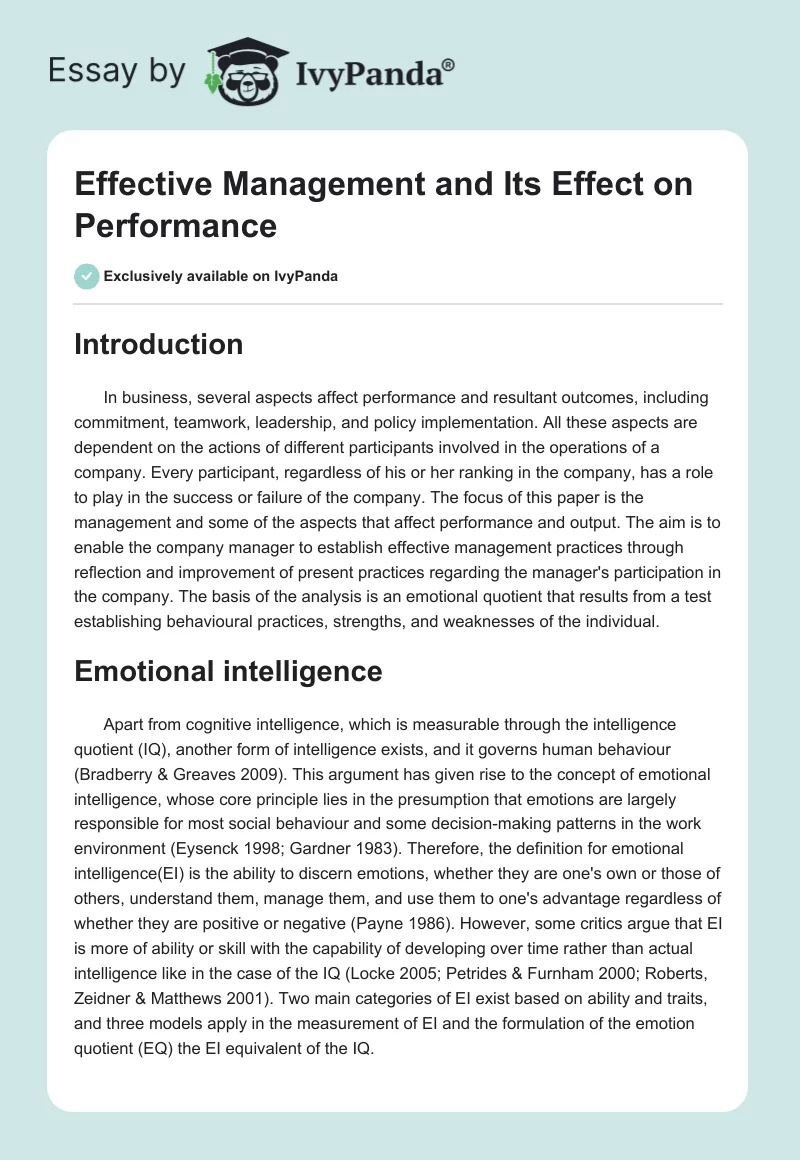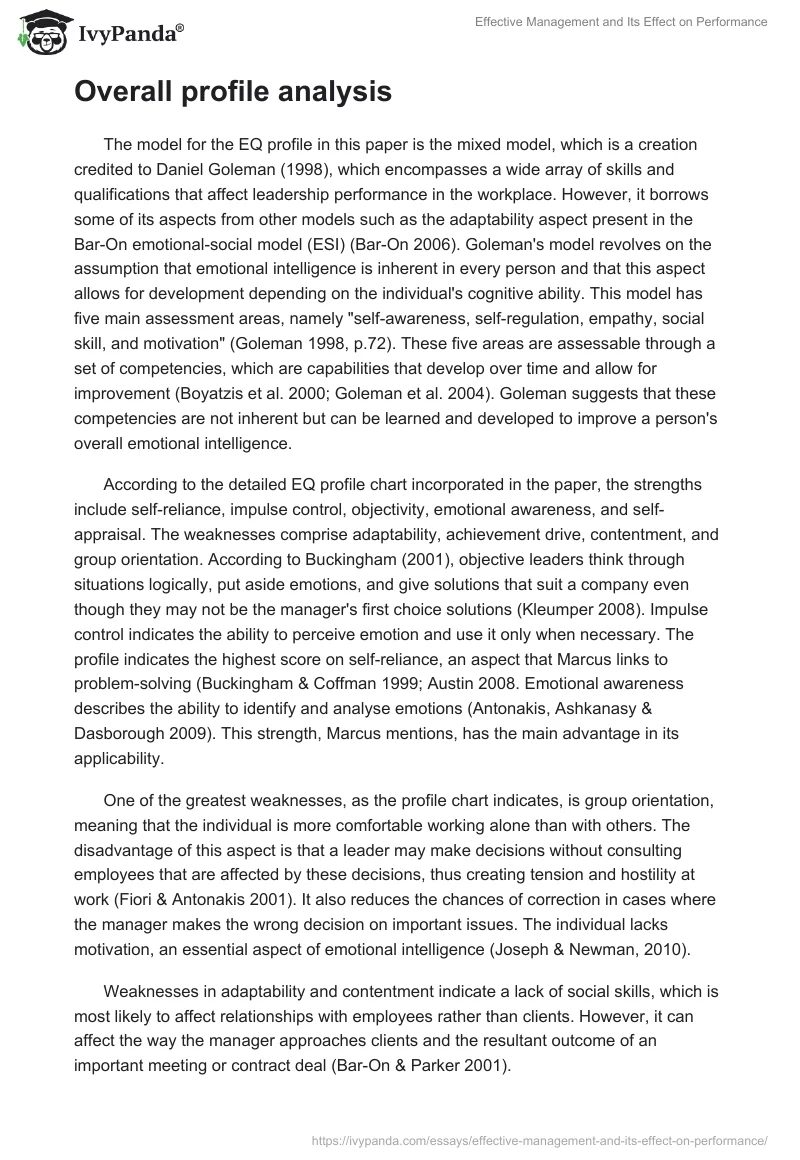Introduction
In business, several aspects affect performance and resultant outcomes, including commitment, teamwork, leadership, and policy implementation. All these aspects are dependent on the actions of different participants involved in the operations of a company. Every participant, regardless of his or her ranking in the company, has a role to play in the success or failure of the company. The focus of this paper is the management and some of the aspects that affect performance and output. The aim is to enable the company manager to establish effective management practices through reflection and improvement of present practices regarding the manager’s participation in the company. The basis of the analysis is an emotional quotient that results from a test establishing behavioural practices, strengths, and weaknesses of the individual.
Emotional intelligence
Apart from cognitive intelligence, which is measurable through the intelligence quotient (IQ), another form of intelligence exists, and it governs human behaviour (Bradberry & Greaves 2009). This argument has given rise to the concept of emotional intelligence, whose core principle lies in the presumption that emotions are largely responsible for most social behaviour and some decision-making patterns in the work environment (Eysenck 1998; Gardner 1983). Therefore, the definition for emotional intelligence(EI) is the ability to discern emotions, whether they are one’s own or those of others, understand them, manage them, and use them to one’s advantage regardless of whether they are positive or negative (Payne 1986). However, some critics argue that EI is more of ability or skill with the capability of developing over time rather than actual intelligence like in the case of the IQ (Locke 2005; Petrides & Furnham 2000; Roberts, Zeidner & Matthews 2001). Two main categories of EI exist based on ability and traits, and three models apply in the measurement of EI and the formulation of the emotion quotient (EQ) the EI equivalent of the IQ.
Overall profile analysis
The model for the EQ profile in this paper is the mixed model, which is a creation credited to Daniel Goleman (1998), which encompasses a wide array of skills and qualifications that affect leadership performance in the workplace. However, it borrows some of its aspects from other models such as the adaptability aspect present in the Bar-On emotional-social model (ESI) (Bar-On 2006). Goleman’s model revolves on the assumption that emotional intelligence is inherent in every person and that this aspect allows for development depending on the individual’s cognitive ability. This model has five main assessment areas, namely “self-awareness, self-regulation, empathy, social skill, and motivation” (Goleman 1998, p.72). These five areas are assessable through a set of competencies, which are capabilities that develop over time and allow for improvement (Boyatzis et al. 2000; Goleman et al. 2004). Goleman suggests that these competencies are not inherent but can be learned and developed to improve a person’s overall emotional intelligence.
According to the detailed EQ profile chart incorporated in the paper, the strengths include self-reliance, impulse control, objectivity, emotional awareness, and self-appraisal. The weaknesses comprise adaptability, achievement drive, contentment, and group orientation. According to Buckingham (2001), objective leaders think through situations logically, put aside emotions, and give solutions that suit a company even though they may not be the manager’s first choice solutions (Kleumper 2008). Impulse control indicates the ability to perceive emotion and use it only when necessary. The profile indicates the highest score on self-reliance, an aspect that Marcus links to problem-solving (Buckingham & Coffman 1999; Austin 2008. Emotional awareness describes the ability to identify and analyse emotions (Antonakis, Ashkanasy & Dasborough 2009). This strength, Marcus mentions, has the main advantage in its applicability.
One of the greatest weaknesses, as the profile chart indicates, is group orientation, meaning that the individual is more comfortable working alone than with others. The disadvantage of this aspect is that a leader may make decisions without consulting employees that are affected by these decisions, thus creating tension and hostility at work (Fiori & Antonakis 2001). It also reduces the chances of correction in cases where the manager makes the wrong decision on important issues. The individual lacks motivation, an essential aspect of emotional intelligence (Joseph & Newman, 2010).
Weaknesses in adaptability and contentment indicate a lack of social skills, which is most likely to affect relationships with employees rather than clients. However, it can affect the way the manager approaches clients and the resultant outcome of an important meeting or contract deal (Bar-On & Parker 2001).
However, to ensure that self-evaluation is complete and objective, an individual has to apply a 360 analysis involving consideration of analysis by people around him or her. Sometimes what people consider as their weaknesses of strengths fall under different classification from a different perspective. According to the360 analysis, there are a few differences from results in the individual EQ profile. In some instances, the individual ranked higher and others lower in the self-evaluation compared to an analysis by other people such as peers and the line manager. Some of the indicators that ranked higher in self-evaluation include building excellence, building confidence and analytical thinking. Information gathering, empathy, communication and consumer centricity are the main indicators in which others gave higher rankings than that of the individual. In some instances, results from the self-evaluation and those from independent evaluations showed substantial similarities. For instance, scores on pro-activity and collaboration were similar.
An overlay of results from both tests shows that sometimes an individual may underestimate his or her abilities while overestimating others. In most cases, independent sources provide objective evaluations as individuals are inherently prejudicial regarding their abilities and inabilities. For instance, in most cases, introverts would classify activities done in seclusion as their niche, which may not always be true. In the case study, the individual records a high score on self –reliance in the EQ profile and a low score in communication, indicating his or her view on introvert-aligned activities, while the 360 profile analysis by others indicates a higher communication capability and higher scores on customer-centricity.
The importance of the overlay is that it enables an individual to discern his or her prejudices in addition to working on areas with lower scores.
Time management
The timetables indicate that the manager uses most time working on the company-related activities and a little time on personal activities. According to Stephen Covey’s time management concept, it is ideal for giving importance to activities that lead to the achievement of goals according to the desired direction of the company (Covey, Roger & Merril 1994). This aspect is the definition of success for the company, as opposed to the traditional definition of success based on the balance between financial gain and input. According to Covey’s time management matrix, different emotions fall in four quadrants, viz. “urgent and important, urgent but not important, important but not urgent and not urgent and not important” (Covey, Roger & Merril 1994, p.86).
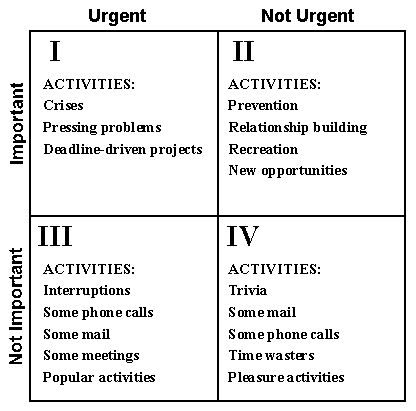
Activities in the first quadrant are critical, and thus they require immediate attention. However, in a company, most activities appear urgent as they affect the income of the business, whether it is attending to repairs or completing projects with deadlines. Such activities in the sample timetables include reviewing invoices and payment of bills. Stephen is of the opinion that due to the number of activities in this quadrant, an individual should complete as many activities as possible but not necessarily all of them. The second quadrant entails activities that are important, but not urgent. However, these activities have long-term effects on the productivity of the company while those in the first quadrant bear immediate effects on the company’s operations (Mintzberg, Ahlstrand & Lampels 1998). Activities in the second quadrant include strategic planning and meetings with future investors. Examples of such activities in the timetables include meetings with the board and staff as well as preparations for presentations. In Covey’s opinion, most managers spend so much time concentrating on accomplishing activities in the first quadrant that they forego on time spent tackling those in the second quadrant. Thus the company suffers stagnation in development. This quadrant consists of activities that create quality and develop both the business and the manager’s leadership skills (McKee, Boyatzis & Johnson 2008).
The third quadrant consists of activities that seem urgent, even though they are not important. Such activities are numerous during work hours and comprise answering phone calls, replying to emails, and taking care of errands that do not necessarily contribute to the development of either the company or individual. Paying a lot of attention to activities in this quadrant has the probability of eroding precious time that has the potential to create improvements. However, it is tricky to decide which activities to focus on in this quadrant and which ones to forgo as they all seem urgent even though they are not important. Company email replies and writing memos are some of the activities that fall in this category that probably apply even though they do not exist on the timetables. The fourth quadrant in the matrix entails activities that Covey suggests should be avoided whenever possible due to their time-wasting capabilities. These activities are neither important nor urgent, examples of which are watching some television programs, engaging in social media interactions for fun or texting, and chatting with friends via emails. Although such activities do not appear on time logs and timetables, they usually happen during breaks from work such as the lunch break, and they still possess the capability to influence the amount and quality of an individual’s work (Salovey & Meyers 1990).
An effective manager should be in a position to discern emotion and control it so that it does not affect his or her work. However, due to the unpredictable nature of emotions, it is advisable to keep from situations that cause emotional vulnerability at work. Staff meetings, board meetings, and meetings with executives of the company are essential in establishing strategic policies for the development of the company. The allocation of time to personal activities such as exercise and family ensures that personal relationships do not suffer at an individual’s peril. Team building activities are also helpful in developing work relationships and letting employees interact with their employers and see them as human beings. Team building is also a good forum for employees to bring up issues that they might have at work.
The main purpose of the time matrix is to enable individuals to prioritise activities and allocate time to them appropriately to maximise on the outcome, which is enabling the achievement of long-term goals. Stephen Covey’s formula is also applicable in the development of personal goals by allocating more time to weak points and a little less time to strength areas. It is possible to prioritise weaknesses into the first quadrant and the rest according to urgency and importance. About the EQ profile, leadership, influence, and negotiation are some of the skills that portray strength, while communication and group interaction portray weaknesses. A potential solution that creates a balance among these strengths and weaknesses is the allocation of more time towards the weaknesses in comparison to the strengths.
Understanding the roles of a manager
To be an efficient and effective manager, it is important to figure out what roles a manager plays in an organisation and how best to effect these roles. Henry Mintzberg offers a criterion for the establishment of these roles by listing ten key roles that are essential in ensuring the smooth running of a company. He classifies these roles into three categories, namely “the interpersonal category, the informational category, and the decisional category” (Mintzberg 2008, p.42). In the interpersonal category are roles that involve the manager’s ability to supply information and uphold the company’s image. As a figurehead, a manager represents the company’s image, and thus his or her actions need to display what the company is about including its goals and objectives. The role of a manager as a liaison involves the creation of networks both within and outside an organisation that serves to benefit the company.
The second category of roles is informational, thus requiring the manager to provide, relay, and process information within and outside an organisation. According to Mintzberg (2008), a manager should be a spokesperson, disseminator, and monitor within the organisation. As a monitor, the manager is required to seek out information that is useful to the organisation and supervise on the activities of co-workers. Disseminating involves the distribution of information within and outside the company that has the potential to develop the company. The role of a spokesperson requires the manager to supply information to people outside the organisation that is representative of the company’s view. The manager is thus ‘the voice’ of the company.
The last category is decisional, thus requiring a manager to make decisions on behalf of the company. The roles in this category include an entrepreneurial role that presents the manager with the opportunity to create and control changes in the company. As a negotiator, a manager is supposed to analyse situations that benefit the company and make appropriate decisions. Resource allocation is another role within this category, with its main requirement being the appropriate distribution of company resources for the maximisation of profit within and outside the company.
Mintzberg’s objective in creating this list is to enable people in management to establish what other people and the company expect of them and adjust their behavioural patterns within the workplace to match these expectations (Mintzberg, Ahlstrand & Lampels 1998, p.99). This works through self-evaluation, whereby an individual rates himself or herself on a scale of 1-5 and works on the areas with low scores. For instance, in this exercise, the results of the self-evaluation stand as follows: effective communication at 3/5, influence and negotiation at 4/5, planning and organisation at 3/5 and leadership at 4/5. To improve communication, activities that involve social connections such as the company picnic are important in improving that specific role as a manager.
John Adair presents the idea of action-centred leadership, in which he suggests that effective management involves active involvement in important activities in the company. He posits that for the manager to understand his/her role, s/he needs to experience activities as opposed to supervision as is usually the tradition (Adair 1979). This concept is crucial in the creation of a better understanding of the functions each person plays in the organisation and what it takes to achieve certain goals. However, it is difficult to enact the theory in practice because as a manager, one has to switch between several different roles at a time and therefore, a delegation of most responsibilities is inevitable.
Conclusion
Although there is controversy on the viability of emotional intelligence as a form of intelligence, it is irrefutable that emotions affect behaviour in the workplace. Therefore, understanding one’s emotions and having the ability to discern strengths and weaknesses plays a significant role in developing behaviour that depicts effective management. The EQ profile is one of the self-evaluation methods that one can apply to determine his or her strengths. It also aids in establishing weaknesses that need improvement for the good of the individual and the company. However, this method contains a flaw as it operates without the consideration of personal prejudices. To remedy the flaw, this paper uses a 360 form of analysis that involves the independent opinions of other people. The essence of this analysis is to expose misconceptions in the EQ profile and build on a more objective means of self-improvement. An overlay of the two methodologies creates a wholesome evaluation and a better criterion to follow. The Stephen Covey time matrix applies in helping prioritise weaknesses that need immediate attention and those that should not concern the individual depending on the individual’s goals, in effect, creating a roadmap to effective management. It helps establish what is important and needs attention and help in the elimination of behaviour or activities that are time-wasting in nature as far as the achievement of goals is concerned. In conclusion, the use of just one formula is not enough in the creation of an effective manager. The combination of several formulae leads to the creation of more objective improvement criterion in management.
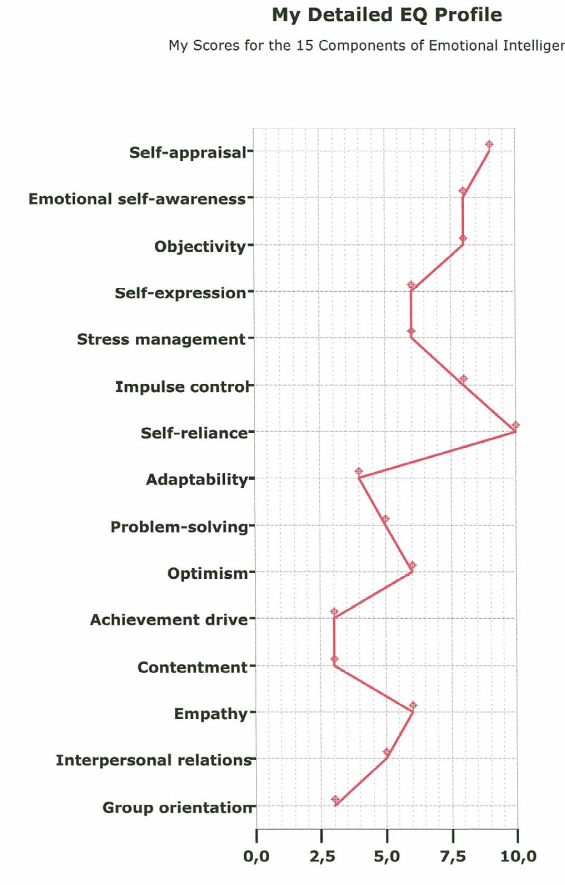
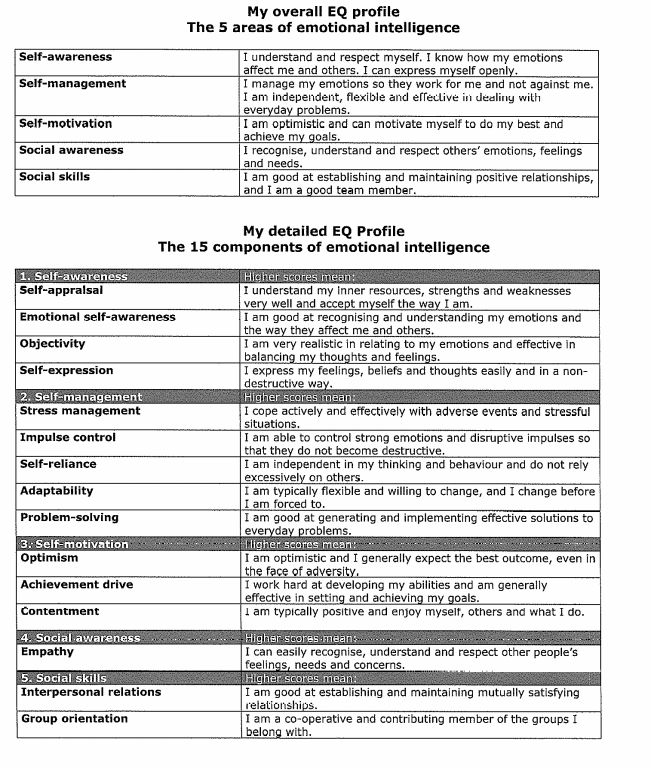
Reference List
Adair, J 1979, Action Centred Leadership, Gower Publishing Ltd, Farnham.
Antonakis, J, Ashkanasy, M & Dasborough, M 2009, ‘Does Leadership Need Emotional Intelligence’, The Leadership Quarterly, vol. 20 no.2, pp. 247-261.
Austin, E 2008, ‘A reaction time study of responses to trait and ability emotional intelligence test items’, Personality and Individual Differences, vol.36, pp. 1855-1864.
Bar-On, R 2006, ‘The Bar-On Model of Emotional Social Intelligence (ESI)’, Psicothema, vol.18, pp. 13-25
Bar-On, R & Parker, J 2000, Handbook of Emotional Intelligence: Theory Development, Assessment, and Application at Home, School and in the Work Place, Jossey Bass, San Francisco.
Boyatzis, R, Goleman, D & Rhee, K 2000, “Clustering Competence in Emotional Intelligence: Insights from the Emotional Competence Inventory (ECI)”, in R Bar-On & J. D Parker (eds), Handbook of Emotional Intelligence, Jossey Bass, San Francisco, pp. 343-362
Bradberry, T & Greaves, J 2009, Emotional Intelligence, Publishers Group West, San Francisco.
Buckingham, M 2001, Now, Discover Your Strengths, Free Press, New York.
Buckingham, M & Coffman, C 1999, First, Break All the Rules: What the World’s Greatest Managers Do Differently, Simon and Schuster, New York.
Covey, S, Roger, A & Merill, R.1994, First Things First, Free Press, New York.
Eysenck, H 1998, Intelligence: A New Look, Transaction Publishers, New Jersey.
Fiori, M & Antonakis, J 2011, ‘The Ability Model of Emotional Intelligence: Searching for Valid measures’, Personality and Individual Differences, vol. 50 no.3, pp. 409-415.
Gardner, H 1983, Frames of Mind, Basic Books, New York.
Goleman, D 1998, Working with Emotional Intelligence, Jossey Press, San Francisco.
Goleman, D, Boyatzis, R & McKee, A 2004, Primal Leadership: Learning to Lead with Emotional Intelligence, Harvard Business School Press, Boston.
Joseph, D & Newman, A. 2010, ‘Emotional Intelligence: An Integrative Meta-analysis and Cascading Models’, Journal of Applied Psychology, vol. 95 no.1, pp. 54-78.
Kleumper, H 2008, ‘Trait Emotional Intelligence: The Impact of Core Self-Evaluation and Social Desirability’, Personality and Individual Differences, vol. 44 no. 6, pp. 1409-21.
Locke, E 2005, ‘Why Emotional Intelligence is an Invalid Concept’, Journal of Organisational Behaviour, vol. 26 no. 4, pp.425-431.
McKee, A, Boyatzis, R & Johnston, F 2008, Becoming a Resonant Leader: Develop your Emotional Intelligence, Renew Your Relationships, Sustain Your Effectiveness, Harvard Business School Press, Boston.
Mintzberg, H 2008, Mintzberg on Management, Simon and Schuster, New York.
Mintzberg, H, Ahlstrand, B & Lampel, J 1998, Strategy Safari: A Guided Tour through the Wilds of Strategic Management, Free Press, New York.
Payne, W 1986, A Study of Emotion: Developing Emotional Intelligence: Self-Integration; Relating to fear, pain and desire, UMI Dissertation Services, Ann Arbor.
Petrides, K & Furnham, A 2000, ‘On the dimensional structure of emotional intelligence’, Personality and Individual Differences, vol. 29, pp.313-320.
Roberts, R, Zeidner, M & Mattews, G 2001, ‘Does Emotional Intelligence Meet Traditional Standards for an Intelligence: Some New Data and Conclusions”, Emotion, vol. 1, pp.196-231.
Salovey, P & Mayers, D 1990, ‘Emotional Intelligence’, Imagination, Cognition, and Personality, vol. 9, no.1, pp.185-211.

